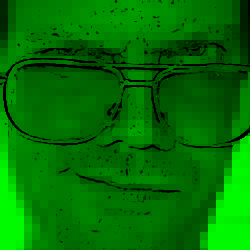This book was interesting, a lot more interesting than I expected. After all, I'm not a punk. I didn't grow up a punk. So why would I read—brace yourself—an oral history of the SF bay area punk scene? I learned plenty.
OK, here's what I love about punk: the DIY thing. Instead of worshiping some band, remember that you and your friends can start your own band. This book gives an interesting view into how this played out (and plays out) in the bay area. (The bay area isn't the only place this happened. If there are similar books/websites/whatever about this in similar areas, I'd to know about them.) Punk didn't really start out as a DIY thing, after all. It started out as a bunch of me-too kids who dressed up like the Sex Pistols, Ramones, or... yeah.
The DIY attitude was popularized by some dude named Tim Yohannon. He ran a magazine called Maximum Rock & Roll. I'd heard of the magazine but never read it; from the title, I figured it was full of hair metal cock-rock garbage. But, from this book, I find out it's all DIY and lefty and promoting little bands. (There's also a lot of more-correctly-liberal-than-thou "that band signed with a major label therefore they sold out" tall-poppy-cutting crapola; ...but maybe that's worth putting up with.) Tim Yohannon was also one of the founders of Gilman St, though he got out of it later and wasn't so happy at first when the generation of kids self-organized and ran the place.
How did people organize before there was an internet? How did social networking work before there were social networking sites? If you were a band in Arkansas trying to put together a national tour of underground places, how could you find out where to play, who to talk to? How do you organize that kind of word-of-mouth; what kind of society needs to be in place to nurture those connections? Shows, 'zines, phones, community, trust in foafs...
Anyhow, the book. The book consists of snippets from interviews. They're organized into chapters. Most chapters are about some band or about some institution. There's a chapter about, say, Green Day, with quotes from various folks, roughly arranged so that they're talking about things chronologically. It works well.
It makes me kinda glad that I wasn't part of the punk scene. It gets scary violent. Some of these kids were out living on the streets because they were trying to get away from bad situations. Some of these kids were bad situations themselves. What do you do when nazi skinhead assholes decide that your music is appropriate accompaniment for fights? Yeah, some of this stuff, I'm glad I'm getting through book-larning.
Some fun nuggets along the way:
- That X on the hand for straight edge came from San Francisco, the Mabuhay Gardens:
Tom Flynn: If you were under 21 they'd put the X on your hand.
Ian MacKaye: The Teen Idles went to California in 1980. [Dirk] Dirksen [Mabuhay show booker] was letting kids into shows, and he'd put an X on their hands. So we went back to Washington, to the 930 Club, and we said, "Hey, we want to see these shows. And we'll put an X on our hands if you let us in. And if you see us drink, you can kick us out forever." We got the idea from the Mabuhay. - There's this guy Mike Hennessey. He was sherriff of San Francisco for a long time, a pretty good one. He went to punk shows back in the 70s. He's in the book; he talks about being invited to DJ on the Maximum Rock & Roll radio show, that he picked out "I Fought the Law" and "Police Truck", while sherriff. Awesome.
- The Deaf Club: Every so often you hear that deaf people like loud music because they can feel the vibrations. But I didn't know that for a year and a half, a community center for deaf folks hosted punk shows.
Dennis Kernohan: The deaf people were there with balloons, holding them up and feeling the vibrations to the Germs, all these fuckin' great bands, and using these balloons and dancing around. For a tough old punk, it just made your heart—it gave you that beautiful feeling. They loved the music, and we were making money for them. - That silly fashion choice could save your life, if you're one of a bunch of punks squatting in an abandoned beer-vat-warehouse space and it catches fire:
Tammy Lundy: Robbie Cryptcrasher, who use to play with Cause for Alarm, saved my life. He used to wear a gas mask on his belt. It was just punk rock kitsch, but when everyone started choking, he put it on and it worked. Robbie was dragging out his girlfriend Michelle, who was already unconscious. He had to drop her down half a story. I slid down the ladder and landed on Michelle. Then he hooked one arm under each of us and pulled both of us out and kicked the doors open to great cheers. - If punk was a reaction against rock stars, maybe homopunk was a reaction against disco:
Lynn Breedlove: We'd be listening to KALX on the way to the bars, and then we'd have to listen to disco to hang out with other queers. It was terrible.
Oh, I see the book has a web site, with some material that didn't make it into the book: Gimme Something Better. I wanted more after reading that book, so I guess I'll go read the site.
